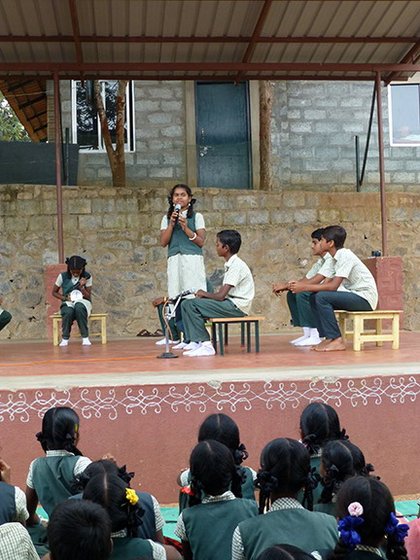
Subject matter information is now available to children at their fingertips. For instance, if you want to know about Newton’s Third Law of Motion, you can search the internet and find many explanations and examples. So, schools have to move beyond teaching subjects like physics, chemistry, history and start working on values like peace and empathy. At Vidya Vanam we try to integrate such values and ethics into the school environment and routine.
Cultivating values through teaching-learning process and school environment

The following three are a high priority for us when it comes to inculcating social, emotional and life skills in children.
-
A fear free environment — We have a fear free environment in the school. A class 11 student can walk up to the head of the school and express what they feel freely. They also have a similar relationship with their teachers. Children address all the adults here as “Anna” (big brother) or “Akka”(elder sister). Such openness is very important for us because we are serving a community that has been oppressed in society for generations. Here, children develop confidence to deal with the world.
-
Empathy — This is the most important quality we want to develop in children. It is easy to be sympathetic and walk away. However, our focus is on developing empathy in our children. For example, in our previous batch of students, we had a few children who were not doing very well academically. The classmates decided on their own to help out these students because they had grown up together and they felt they couldn’t leave their peers behind. One of these students has now been accepted into one of the top colleges in Coimbatore. This is an illustration of how the school practices and culture naturally enable the development of empathy in children. We don’t have a moral science class. We try to integrate values and morals in whatever we teach. For instance, I teach Business Studies. When I talk about a brand like Coca-Cola, I don’t just talk about the company’s marketing success, but also draw the students’ attention to the social impact of the company’s activities. In this example, we discuss how Coca-Cola has been banned in Pattinam because of groundwater contamination. Such examples help children think critically and not get carried away by marketing. It also helps students understand the lives of the community and how actions of one group can affect the lives of another. Likewise, children need to know what happened during the Sterlite protests, or the Bhopal Gas tragedy. Understanding such issues is the first step towards building empathy.
-
Developing a sense of community and peace — Conflicts are natural in any group of people coming together. Often children may get into a conflict with their peers or anyone else at school. We try to role model for them how to deal with conflicts with empathy and compassion. For instance, below are a few things I do as the head of the school.
-
I don’t take sides and let the conflict become personal. I look at the issue and help them sort it out.
-
I never make an assessment based on what I hear from others. I make sure to speak to all the people concerned and hear their side of the story.
-
At the end of this process, when you trace the incident you find who did what and what could have been done differently. We try to arrive at this understanding collectively rather than by meting out punishment or warning. Such an inclusive process helps children develop their own ability to think and take the right decisions rather than do it out of fear of authority. These practices set an example for students while dealing with conflicts at their own level. A collective process of negotiation and arriving at decisions also helps students develop a sense of belonging to the institution.
Building the school team
Children don’t follow what you say, they follow what you do. So, we need to do a lot of work on our own mindsets and behaviors as educators to set the right example for children. What has also helped us in creating a cohesive culture is that most of our teachers come from surrounding areas. They have grown with the school. For instance, one of our teachers came in as a bricklayer when we were building the school. She joined us as a helper in the school. Today she is the music teacher who has completed a BA in Music and is pursuing MA in History. Similarly, many other teachers started working with us after they completed Class 10 or 11 in the government school here. They have now finished their MA and M.Ed degrees.
However, we sometimes discover that teachers hold the same beliefs that we are trying to change. For instance, there was a suggestion by a teacher that when a girl was going through her menstrual cycle she needed to sit outside the class. I need to be careful not to debunk or be dismissive of such beliefs. We need to have respect for a person’s beliefs because these are a part of their conditioning. We try to have a dialogue with the person and help them examine the basis of the practice, how it is holding them back and what could be more practical ways of dealing with their apprehensions.
I can recall another incident — a girl wrote a love letter to a boy in the school. The teacher was very upset about this. Also, there is a certain taboo about these topics in the community. As educators however, we need to understand that there is a natural growth process children go through and experience a whole range of emotions. We need to help them deal with them responsibly without making them feel ashamed or scared. In this particular example, I met the student along with the teacher and calmly asked her to explain what happened. She was scared initially, so I had to reassure her that there is nothing to worry about. She opened up and told me what she felt about the boy. I dealt with the matter lightly, telling her it was no big deal. She should make friends with him and play together, but avoid writing letters. As a school leader I need to pay sufficient attention to the issue and guide the students about these matters, yet ensure it is not blown out of proportion.
These are some ways in which we teach children to engage with each other in a healthy way, yet be mindful that the environment and reactions in the community are different. We need to help children deal with these issues to prepare them for life beyond the community, yet be respectful of the norms of their community. This is our endeavor - to send them out as confident and responsible citizens, who will not just do well for themselves, but will also be compassionate and empathetic towards others.
